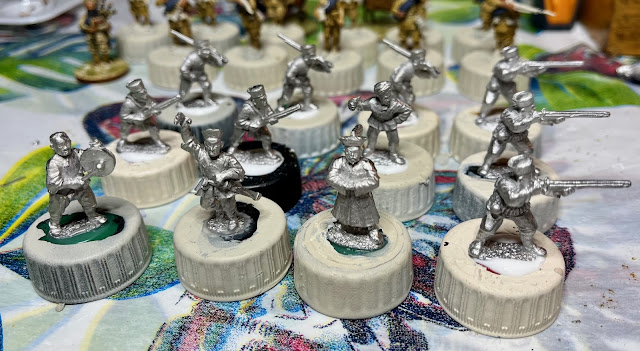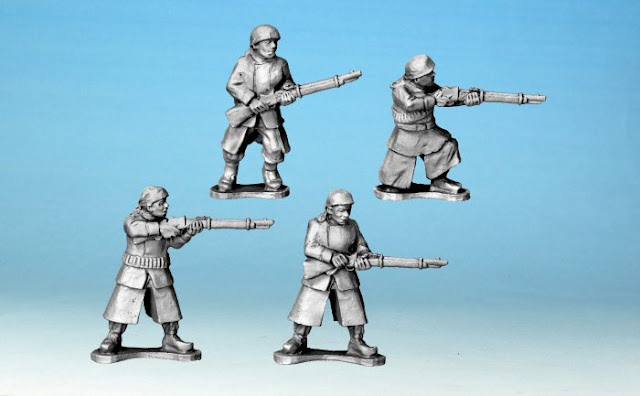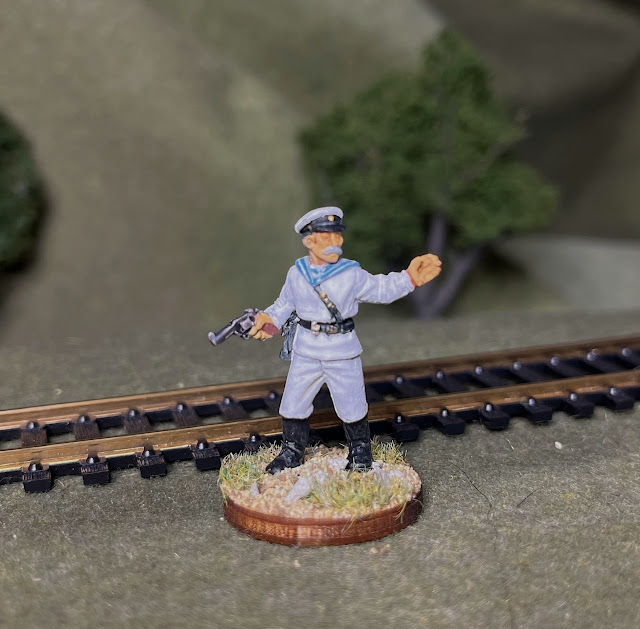So far that's what I'm doing though eventually I will have some troops for Admiral Seymour's relief attempt, the follow-up expeditions after Peking was captured, and the Legation defense.
Most young boys (and some adventurous girls) play with Toy Soldiers; some never stop! I'm proud to say that I am one that never has stopped. Toy Soldiers, painting the figures, history and miniature wargaming is what this site is all about. May the God who gives encouragement give you the same attitude of mind toward each other that Christ Jesus had, so that with one mind and one voice you may glorify the God and Father of our Lord Jesus Christ.

As an Amazon Associate I earn from qualifying purchases
Thursday, August 7, 2025
The Boxer Rebellion Project, Part 10: Generic 8 Nations Field Forces of General Gaselee's Relief Force
So far that's what I'm doing though eventually I will have some troops for Admiral Seymour's relief attempt, the follow-up expeditions after Peking was captured, and the Legation defense.
 I'm a retired Colonel of Infantry (Regulars by God!) and Military Historian who likes to play with toy soldiers. I've been married to the love of my life since 1986, I have 5 honorable sons (my geeks in training), 4 daughters-in-law, al2 grandsons, 1 granddaughter, 1 dog and a gazillion miniatures.
Hobbies include . . . wait for it . . . Toy Soldiers, Reading, Wargaming, Reading about Toy Soldiers, History, Reading about Wargaming, Gardening, Reading about History and Reading.
I'm a retired Colonel of Infantry (Regulars by God!) and Military Historian who likes to play with toy soldiers. I've been married to the love of my life since 1986, I have 5 honorable sons (my geeks in training), 4 daughters-in-law, al2 grandsons, 1 granddaughter, 1 dog and a gazillion miniatures.
Hobbies include . . . wait for it . . . Toy Soldiers, Reading, Wargaming, Reading about Toy Soldiers, History, Reading about Wargaming, Gardening, Reading about History and Reading.
Monday, August 4, 2025
The Boxer Rebellion Project, Part 9: 1st Sikh Regiment, Punjab Frontier Force
 I'm a retired Colonel of Infantry (Regulars by God!) and Military Historian who likes to play with toy soldiers. I've been married to the love of my life since 1986, I have 5 honorable sons (my geeks in training), 4 daughters-in-law, al2 grandsons, 1 granddaughter, 1 dog and a gazillion miniatures.
Hobbies include . . . wait for it . . . Toy Soldiers, Reading, Wargaming, Reading about Toy Soldiers, History, Reading about Wargaming, Gardening, Reading about History and Reading.
I'm a retired Colonel of Infantry (Regulars by God!) and Military Historian who likes to play with toy soldiers. I've been married to the love of my life since 1986, I have 5 honorable sons (my geeks in training), 4 daughters-in-law, al2 grandsons, 1 granddaughter, 1 dog and a gazillion miniatures.
Hobbies include . . . wait for it . . . Toy Soldiers, Reading, Wargaming, Reading about Toy Soldiers, History, Reading about Wargaming, Gardening, Reading about History and Reading.
Tuesday, July 22, 2025
The Boxer Rebellion Project, Part 8: A Generic Imperial Chinese Field Force
Now that I have more than a start on the 8 Nations Alliance for the Boxer Rebellion, it's time to turn my attention to the Imperial Chinese Army and the Boxers. I'm a great fan of The Men Who Would be Kings which is my kind of Colonial Colonial Gaming. In researching my army, I'm also going to give a nod to making the Field Force as colorful and with as many flags as possible. My army will be semi-historical with an eye to gaming and having fun.
Right now I'm focusing on forces during the Second Relief Force when the 8 Nations Alliance forces under Lt. General Sir Alfred Gaselee marched on Peking to relieve the Internation Legaitions. Once the Taku Forts were taken, the Imperial Chinese, which had forces actively fighting the Boxers, viewed the action as a declaration of war and the Boxers started to take a back seat to the Imperial Army. But hey, we are going to have lots of Boxers for the Imperial Chinese commander as cannon fodder, um, ahem, as loyal citizens helping the Qing Dynasty.
5. Imperial Chinese Artillery.
 I'm a retired Colonel of Infantry (Regulars by God!) and Military Historian who likes to play with toy soldiers. I've been married to the love of my life since 1986, I have 5 honorable sons (my geeks in training), 4 daughters-in-law, al2 grandsons, 1 granddaughter, 1 dog and a gazillion miniatures.
Hobbies include . . . wait for it . . . Toy Soldiers, Reading, Wargaming, Reading about Toy Soldiers, History, Reading about Wargaming, Gardening, Reading about History and Reading.
I'm a retired Colonel of Infantry (Regulars by God!) and Military Historian who likes to play with toy soldiers. I've been married to the love of my life since 1986, I have 5 honorable sons (my geeks in training), 4 daughters-in-law, al2 grandsons, 1 granddaughter, 1 dog and a gazillion miniatures.
Hobbies include . . . wait for it . . . Toy Soldiers, Reading, Wargaming, Reading about Toy Soldiers, History, Reading about Wargaming, Gardening, Reading about History and Reading.
Tuesday, July 15, 2025
The Boxer Rebellion Project, Part 7: We Need a Flag?
Then: Surprise! When I went to glue the wire staff to the figure I had forgotten to check the fit before I added the super glue. Of course I got super glue on my fingers and messed up the staff under the flag with super glue. That's what I get for not taking a deep breath and giving a day.
Okay. Maybe I'll pretend it is battle damage. I paint for gaming distance, and at gaming distance it doesn't look too bad. I'll have to decide later if I'll use one of the excellent flags from Flags of War and get a staff from Tsuba Miniatures. Plus I'll file the palms of the hand!
 I'm a retired Colonel of Infantry (Regulars by God!) and Military Historian who likes to play with toy soldiers. I've been married to the love of my life since 1986, I have 5 honorable sons (my geeks in training), 4 daughters-in-law, al2 grandsons, 1 granddaughter, 1 dog and a gazillion miniatures.
Hobbies include . . . wait for it . . . Toy Soldiers, Reading, Wargaming, Reading about Toy Soldiers, History, Reading about Wargaming, Gardening, Reading about History and Reading.
I'm a retired Colonel of Infantry (Regulars by God!) and Military Historian who likes to play with toy soldiers. I've been married to the love of my life since 1986, I have 5 honorable sons (my geeks in training), 4 daughters-in-law, al2 grandsons, 1 granddaughter, 1 dog and a gazillion miniatures.
Hobbies include . . . wait for it . . . Toy Soldiers, Reading, Wargaming, Reading about Toy Soldiers, History, Reading about Wargaming, Gardening, Reading about History and Reading.
Thursday, July 10, 2025
The Boxer Rebellion Project, Part 7: The Austrian-Hungarian Naval Ground Contingent
So why do the smallest contingent of the 8 Nations Alliance? I blame the von Trapp Family Singers.
As regular readers of my blog know, while recovering from foot surgery (hmmm . . . how long was I in the infantry?) I watched the movie The von Trapp Family: A Life of Music based on Agathe von Trapp's memoir (the oldest daughter), Memories Before and After The Sound of Music. Researching Captain von Trapp's military career I discovered: HOLY COW!!! HE WAS DECORATED FOR BRAVERY AS A NAVAL CADET DURING THE BOXER REBELLION! Thus a project was born.
 I'm a retired Colonel of Infantry (Regulars by God!) and Military Historian who likes to play with toy soldiers. I've been married to the love of my life since 1986, I have 5 honorable sons (my geeks in training), 4 daughters-in-law, al2 grandsons, 1 granddaughter, 1 dog and a gazillion miniatures.
Hobbies include . . . wait for it . . . Toy Soldiers, Reading, Wargaming, Reading about Toy Soldiers, History, Reading about Wargaming, Gardening, Reading about History and Reading.
I'm a retired Colonel of Infantry (Regulars by God!) and Military Historian who likes to play with toy soldiers. I've been married to the love of my life since 1986, I have 5 honorable sons (my geeks in training), 4 daughters-in-law, al2 grandsons, 1 granddaughter, 1 dog and a gazillion miniatures.
Hobbies include . . . wait for it . . . Toy Soldiers, Reading, Wargaming, Reading about Toy Soldiers, History, Reading about Wargaming, Gardening, Reading about History and Reading.
Monday, July 7, 2025
The Boxer Rebellion Project, Part 6: We Need a Flag!
 I'm a retired Colonel of Infantry (Regulars by God!) and Military Historian who likes to play with toy soldiers. I've been married to the love of my life since 1986, I have 5 honorable sons (my geeks in training), 4 daughters-in-law, al2 grandsons, 1 granddaughter, 1 dog and a gazillion miniatures.
Hobbies include . . . wait for it . . . Toy Soldiers, Reading, Wargaming, Reading about Toy Soldiers, History, Reading about Wargaming, Gardening, Reading about History and Reading.
I'm a retired Colonel of Infantry (Regulars by God!) and Military Historian who likes to play with toy soldiers. I've been married to the love of my life since 1986, I have 5 honorable sons (my geeks in training), 4 daughters-in-law, al2 grandsons, 1 granddaughter, 1 dog and a gazillion miniatures.
Hobbies include . . . wait for it . . . Toy Soldiers, Reading, Wargaming, Reading about Toy Soldiers, History, Reading about Wargaming, Gardening, Reading about History and Reading.








_1905.jpg)






,_56th_(8FF),_59th_(1FF).jpg)
































.svg.png)


